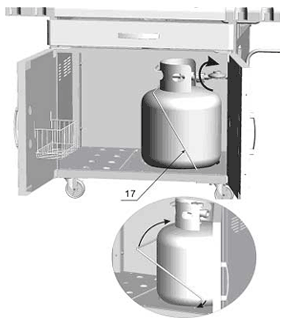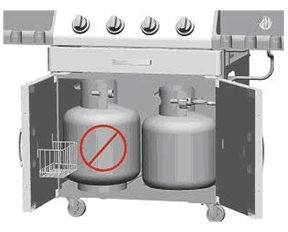GRILL CARE & MAINTENANCE
Care and Maintenance
Caution
All cleaning and maintenance should be done when grill is cool and when the fuel supply is turned off at the control c NOT clean any grill part in a self cleaning oven. The extreme heat will damage the finish.
Cleaning
Outside surfaces | Use a mild dishwashing detergent and hot water solution to clean. Then, rinse with water. | ||||||
Lid (inside) | grease buildup has turned to carbon and is flaking off. Clean thoroughly with strong solution of detergent and hot water. Rinse with water and allow to completely dry. | ||||||
Interior of grill bottom | Remove residue using brush, scraper and/or cleaning pad. Then, wash with dishwashing detergent and hot water solution. Rinse with water and let thoroughly dry. | ||||||
Cooking Grids | care not to chip. Use mild dishwashing detergent or baking soda and hot water solution. Non abrasive scouring powder can be used on stubborn stains, then rinse with water. | ||||||
Heat Plates | Clean residue with wire brush and wash with soapy water, then rinse with water. | ||||||
Grease Cup | Regularly empty the grease cup and clean with dishwashing detergent and hot water solution. | ||||||
Burner assembly |
**Inspect burner for any damage (cracks or holes). If damage is found, replace with new burner. Reinstall burner; check to insure that gas valve orifices are correctly positioned inside burner inlet (venturi). Also check position of spark electrode.
| ||||||
Recommended cleaning materials | Burning-off the grill after every use (approx. 15 minutes) will keep excessive food residue from building up.
DO NOT use cleaners that contain acid, mineral spirits or xylene. |
Connecting your Natural Gas

Before Connection
- Connect a manual shutoff valve to gas supply line.
- Apply sealing compound or pipe thread tape of the type resistant to the action of natural gas must be used on all male pipe threads. Apply compound or tape to at least the first three to four threads when making connections.
To Connect
- Attach one end of the Natural Gas hose to the side burner valve.
- Connect the other end, with the quick release connector, of the natural gas hose to manual shut-off valve. (As in the fig. shown on right).
Important
- During any high pressure testing of the gas supply piping system at test pressures in excess of 1/2 psi (3.5kPa), your gas grill and its individual shutoff valve must be disconnected from the gas supply piping system.
- During any low pressure testing of the gas supply piping system at test pressures equal to or less than 1/2 psi (3.5kPa), your gas grill must be isolated from the gas supply piping system by closing its individual manual shutoff valve.
- Warning: Burner valves are pre-tested at the factory to operate on natural gas. If you wish to convert or change it, be sure to contact your grill distributor or dealer FIRST!
A great tasting substitute to use in the Brinkmann fryers is corn oil.
Connecting your Propane Tank

Before Connection
- Place the propane cylinder on the designated tank support area of the grill.
- Confirm that all burner control knobs are in the OFF position before activating the gas supply.
- Be sure that there is no debris caught in the head of the gas cylinder, head of the regulator valve, or in the head of the burner and burner ports.
To Connect
- Insert the nipple of the valve coupling into the tank valve.
- Tighten the connection collar by turning it clockwise with one hand while holding the regulator with the other. (As in the fig. shown on right).
Important
- Disconnect the propane cylinder from the regulator valve when the grill is not in use.
- Do not obstruct the flow of combustion air and ventilation air to the grill.

Why is my stainless steel grill rusting or discoloring?
The perception that many people have is that stainless steel will not rust. Unfortunately, that is not the case in certain conditions. Rust marks are regular steel particles that have become attached to the surface of stainless steel. They may also occur if you are using a steel wool or wire wool scouring pad instead of a nylon scouring pad to clean your grill.
Rusting is a natural oxidation process and may appear on cast-iron and steel parts. Rust will not effect short term performance of your outdoor kitchen. Stainless steel grill parts will not rust. However, weathering and extreme heat can cause a stainless steel hood to turn a tan color. This is discoloration and is not considered a manufacturing defect.
In coastal areas, small rust pits may develop on the surface of your grill that cannot be fully removed by a cleaner. Concentrate bleaches and other solutions containing chlorine can also cause rust pits.
Discoloration– Cooking creates smoke that may eventually coat and discolor the stainless steel surface. To keep discoloration to a minimum, clean after each use. Grease fires will darken the stainless steel surface, but will not affect the integrity of the steel. Periodic cleaning of the cooking surface and the heat distribution plates helps decrease the risk of a fire.
Stainless steel must be cleaned to keep it looking beautiful and to maintain its ability to resist corrosion. The Stainless steel is protected from corrosion by a thin layer of chromium oxide. Oxygen from the atmosphere combines with the chromium in the stainless steel to form this passive chromium oxide film that protects the Stainless steel surface from further corrosion. When the surface is contaminated by dirt, sand, or other materials, this passivation process is hindered and corrosive agents are trapped, allowing corrosion to occur.
How should I care for my stainless steel grill? Can I clean rust off of my grill?
In addition to keeping your grill covered, routine cleaning is necessary to preserve the appearance and corrosion resistant properties of Stainless Steel.
After each use, let your grill cool and then wipe the grill with a soft, damp, soapy cloth and rinse with clean water. It is important to remove any food deposit, marinade or sauce residue from the surface as most marinades are highly acidic and can damage stainless steel.
DO NOT USE STEEL OR WIRE WOOL on your stainless steel. These will score into the stainless surface and allow corrosion to form. Make sure you clean, polish, and protect your grill on a weekly basis with a stainless lubricant to keep it looking like new.
When cleaning, remember to always rub or wipe in the direction of the grain or polish lines in the surface, not across them. Stainless steel cleaners are abrasive and may damage painted or plastic surfaces.
How Should I Care for my Gas Grill?
Maintenance will determine the longevity of your grill parts. So obtain all the material you need to make this process simple and easy. You will need a grill brush, soap-filled steel wool pads, a mild liquid soap, a sponge, and a non-metal scraper. Keep these items at arm's length to avoid a time consuming hunt that only makes the process tedious.
To clean off your cooking grates, run your burners on high for about 15 minutes or until the smoke stops. Then use your brush to clean the cooking grate. Be careful not to scrub too hard as this will damage the grate's coating. Clean the cooking grate before and after every use.
When necessary, use a soapy steel wool pad to remove smoke stains from your lid of. This should not become a regular cleaning method as steel wool may damage the stainless surface. So be sure to use a fine grade of steel wool, and scrub gently. You can also use this cleaning method on your heat plates. However, for stainless steel heat plates, it is best to use a sponge and warm, soapy water, as steel wool can scratch and damage the surface.
Keep the warming racks on your grill clean. Use soapy steel wool and scrub them lightly after every use to remove any greasy residue. The steel wool can also be used to clean the control panel and keep it in good shape. Be sure to rinse the warming racks and control panel thoroughly and dry them.
Take the time to wipe off any grease drippings that fall on the exterior parts of your grill, including the cart panels and shelves as grease can damage the paint on these surfaces. Use a mild liquid soap and a rag, making sure to rinse well afterwards.
Invest in a quality grill cover to protect your grill from the elements. Using a tarp or a low quality cover will only trap the moisture and will harm the surfaces on your grill. A good cover will not only protect it from rain and snow, but also from tree sap and bird waste.
How do I care for my cast iron cooking grates? They have rust on them.
First use: Before using your cooking grate, wash it thoroughly with dishwashing liquid to remove the protective wax coating applied for shipping. Rinse with hot water and dry thoroughly with a cloth or paper towel.
NEVER ALLOW TO RINSE DRY, OR WASH IN A DISHWASHER. Now season the grates to prevent rust and sticking.
Seasoning: A solid vegetable oil is recommended for the initial seasoning. Spread a thin coating of solid vegetable shortening over the entire surface, including all corners, with a paper towel. Do not use salted fats such as butter or margarine. Then, place the grates in barbecue. Turn burners to High and close the lid. Allow barbecue to heat grates for 1 to 1 1/2 hours. Turn all burners to OFF.
Maintenance (every time you grill): Don't do a burn-off after you grill, but rather leave the cooking residues on the grates to keep a protective coating on the iron. Then do a burn-off just before you grill. Gently brush off charred residues with a steel brush.
Notes: The more you use your cast iron grates, the easier the maintenance will become. If you store your grates for extended periods of time, grease very lightly with vegetable shortening and a paper towel. Store your grill in a dry place. If rust appears, it is an indication that the grates have not been seasoned properly or enough or the burn-off method has been used after grilling. You must begin the seasoning process again.
